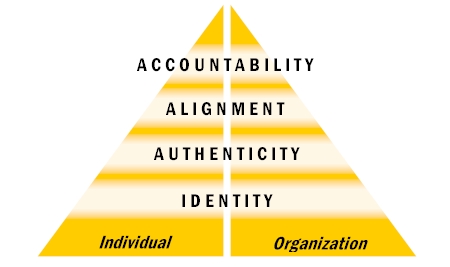A Different Kind of "Identity Theft"
We've heard a lot about "identity theft" lately
- the fraudulent use of others' identification papers, social security
numbers and financial account information. The Identity Theft Resource
Center in San Diego conservatively estimates that the cost of identity
theft in the U.S. alone exceeds $119 billion annually! While not exactly
"identity theft," there is another form of identity loss that exacts a
high toll: loss of "organizational identity."
What is "organizational identity?" Just as who we really are at a personal
level is much more than our identification papers and social security
numbers, an organization's fundamental identity is more than its
incorporation papers, logo or tax I.D. numbers. Personally we each have
unique skill sets, traits and personalities, along with experiences over
our lifetime that contributed to who we are today. Our aims and
aspirations are also part of who we are, which some of us have written
down in the form of personal mission statements, values and goals. Like
individuals, organizations also have unique skill sets, cultures and
histories that have shaped what they are. Organizations have aspirations
as well that typically take the form of statements about purpose, values
and vision. An organization's "brand" is part of its identity, which David
McNally and Karl Speak (Be Your Own Brand) define as a reflection
of others' judgments about the distinctiveness, relevance and consistency
of an organization's purpose, values and vision. Nike, Starbuck's and
Coca-Cola are strong brands because they have created distinct identities
and consistently communicated the distinctiveness and relevance of their
products. Incoherence, irrelevance and inconsistencies around an
organization's purpose, values and vision cause brand corrosion, a major
contributor to loss of an organization's identity.
Here are examples of organizational identity loss that inTEgro has
observed:
• Behavior,
especially senior leadership behavior, that is inconsistent with an
organization's stated purpose or values:
• An organization that stated "Respect" as a core value, but with a
CEO who
regularly rode roughshod over members of his executive team.
• An organization that wanted to pride itself on service, but with
several employees
who greeted practically every internal request with a "You want it
when?" attitude.
None of the employees had ever received anything below "Meets
Expectations"
in years' worth of performance appraisals.
• Failures to recognize
or reward behavior that exemplifies an organization's mission
and values
- like the physician in a private practice who took extra time with the
elderly
and got
high marks from patients but was chastised by partners for not being
efficient
enough.
• A professional
services firm that stated profitability, quality and service as equal
goals
but only
paid attention to cost and profitability measures. Everyone knew that if
you
wanted to
make partner, billings were all that really mattered.
• The classic example I
first heard Douglas McGregor describe as "the folly of
expecting
X but paying Y " - like promoting quality workmanship but not
charging
errors or
returns against bonuses for volume.
Clarity, consistency and alignment around an organization's purpose,
values and vision guard against identity loss, help assure that
organizations live up to their promise, and contribute to what inTEgro
calls "organizational integrity." Customers identify with brands - and
clear, strong brand identities will be only more important as marketplaces
become more crowded with competitive offerings. More than ever people want
to know that they work in organizations that resonate with their purposes,
values and aims. Some experts are predicting that as unemployment eases
there will be pent-up demand by workers for settings that are more attuned
to their values. Evidence includes a 2003 survey by Korn Ferry that
indicated over 70% of respondents would seek a more favorable situation
when the job market improves because they were unhappy about how their
employer handled the economic downturn.
Organizational, or brand, integrity is an "inside-out" job. Twenty years
of experience led us to the conclusion that these are the characteristics
of organizations that successfully guard against identity loss and help
assure that they live up to their promise:
They
have a clear IDENTITY. They know who they are and what they stand for -
their
purpose and core values. They cultivate self-awareness, including of
passions,
strengths and weaknesses.
They
are AUTHENTIC. They act purposefully, empower others to act in support of
the
organization's mission, and assure that deed matches creed. They face
reality
outside
and inside the organization, facilitate courageous conversation and model
truth-telling.
They
strive for ALIGNMENT. There is a kind of harmony to dimensions of life and
work
- a sense of "fit." They align resources with goals, have the capacity to
grow
and
adapt while staying true to their core ideology and promote unity, not
sameness.
They
demonstrate ACCOUNTABILITY. They pay attention to things that matter for
the
short
and long term, and focus on measures that reflect balanced priorities.
They are
responsible stewards, and weigh the impact of their decisions and behavior
on a
broad
group of stakeholders.
One of Minnesota’s best-known examples of a company that models
organizational integrity is Reell Precision Manufacturing. (“Reel” is
German for “integrity.”) They understand the importance of profitability
as any business must, but have consistently – in good times and bad,
walked the talk of their core ideology: “practical application of
spiritual values to promote the common good for the benefit of co-workers
and their families, customers, shareholders, suppliers and community.” Jim
Collins and Jerry Porras’ book Built To Last profiles additional
examples of companies that model organizational integrity like Johnson and
Johnson, Marriott and Merck. (It is important to note that Collins'
research demonstrated how companies that consistently followed their core
ideologies returned twelve times the Dow Jones average return over a
fifty-year period.)

What is true for organizations holds for leaders as well. Think of a
leader you admire, and chances are that person models these
characteristics. We want to follow leaders who know who they are and where
they are going, who demonstrate integrity by walking their talk and who
are accountable.
I once heard that we all have three characters: that which we exhibit,
that which we have and that which we think we have. inTEgro's
Leadership Integrity Survey is designed to reduce inconsistencies
across those three characters by reflecting the strength of IDENTITY,
AUTHENTICITY, ALIGNMENT and ACCOUNTABILITY at the individual level. You
can take the Leadership Integrity Survey free at
www.integro-inc.com/surveys.htm, where you can
also access information about inTEgro's Organizational Integrity Survey.
Integrity - of organizations, brands and leaders - will be one of the most
important and distinguishing requirements for creating real value and for
sustainability. It will become even more important for leaders and
organizations to know who they are and what they stand for, to identify
any factors contributing to loss of that identity and to take corrective
action so they can live up to their promise.

SeaChange Adventures for
Leaders and Teams
Unparalleled development opportunities aboard
Sailing Grace, a 46-foot cutter-rigged sailboat.
 • Leader Pilgrimage — In partnership with InCourage,
a three
• Leader Pilgrimage — In partnership with InCourage,
a three
night/three day sail to put new wind
in your professional and
personal
sails.
(Toronto/Lake Ontario in August 2004)
• “All Hands on
Deck” — team retreats to chart your course,
hone team
skills and build relationships.
(The Great
Lakes in Summer 2004, or New York to Annapolis
September
30 - October 3, 2004)
The sea and sailing have been crucibles for developing leaders and teams
over centuries, and SeaChange Ventures, in partnership with InCourage,
proudly carry on that tradition.
For more information go to
www.integro-inc.com/seachange_ventures.htm or to
www.incourage.com (Click
“Leadership Coaching,” then “Pilgrimages.”)
